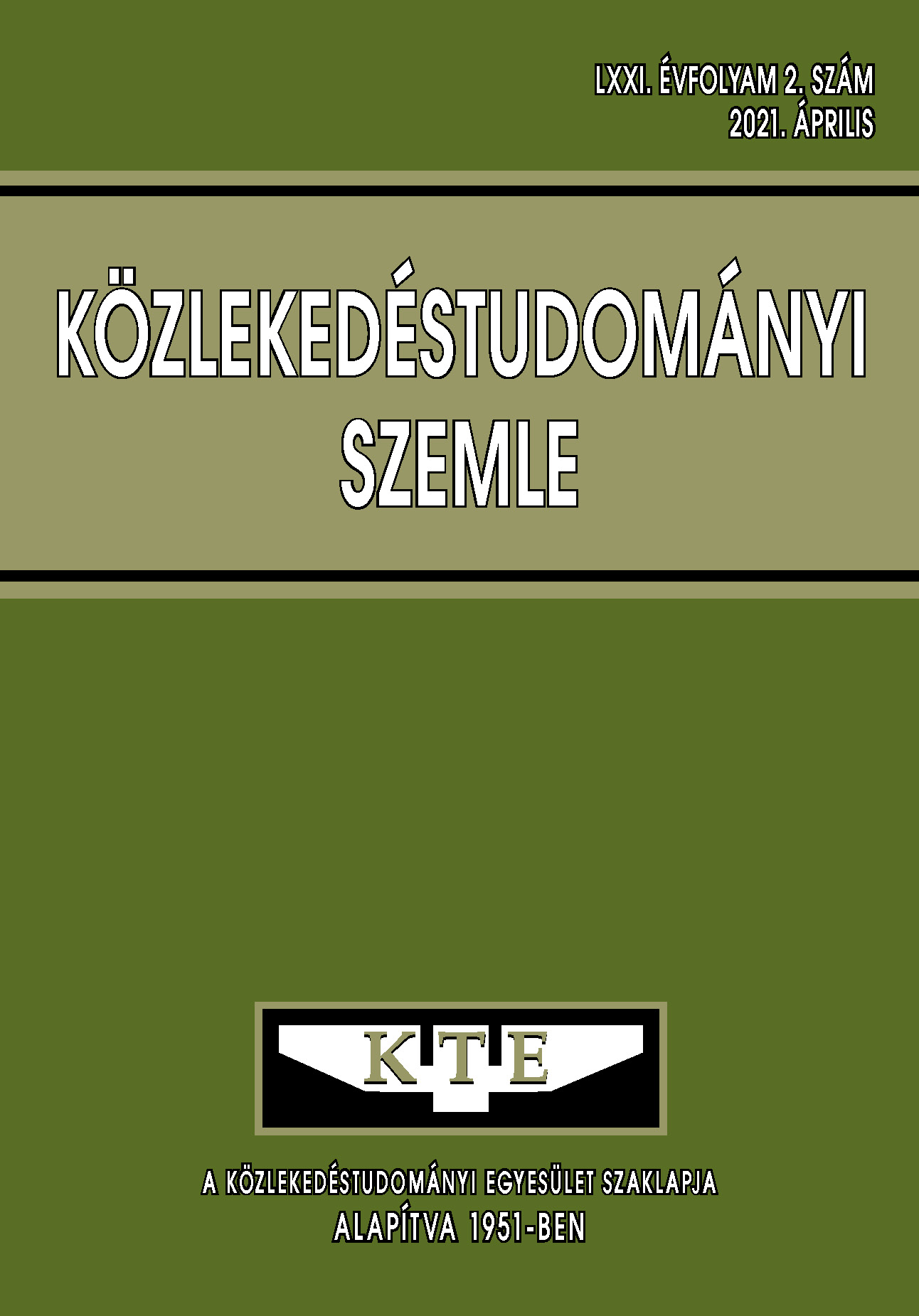Közúti infrastruktúra konfliktus-helyzete a magasan automatizált járművekkel
Absztrakt
A közúti jelzések és a közlekedési infrastruktúra jelentősen befolyásolják a magasan automatizált vagy autonóm járművek viselkedését. Az automatizáltság azonban nem mindig jelent előnyt a jelenlegi közúti infrastruktúra vonatkozásában. Előfordulhat, hogy a magasan automatizált járművek szigorúbban betartják a közlekedési szabályokat,
emiatt az önvezető funkciók váratlan beavatkozásokat hajthatnak végre a járművek haladása közben. Azonban ez sok esetben azért is jelenthet gondot, mert maguk a szabályok sem mindig megfelelők.
Hivatkozások
A. Szele; L. Kisgyörgy, Autonomous Vehicles In Sustainable Cities: More Questions Than Answers, in Sustainable Development and Planning X, WIT Press, 2018 DOI: https://doi.org/10.2495/SDP180611
A. Torok; T. Derenda; M. Zanne,; M. Zoldy, Automatization in road transport: a review Production Engineering Archives, Stowarzyszenie Menedzerow Jakosci i Produkcji, 2018, 20, 3-7 DOI: https://doi.org/10.30657/pea.2018.20.01
C. Csiszár; D. Földes, Operational Model and Impacts of Mobility Service Based on Autonomous Vehicles University of Belgrade, Faculty of Transport and Traffic Engineering, University of Belgrade, Faculty of Transport and Traffic Engineering, 2018
H. Prakken, On the problem of making autonomous vehicles conform to traffic law Artificial Intelligence and Law, Springer Netherlands, 2017, 25, 341-363 DOI: https://doi.org/10.1007/s10506-017-9210-0
C. G.Serna; Y.Ruichek..Classification of Traffic Signs: The European Dataset IEEE Access, Institute of Electrical and Electronics Engineers (IEEE), 2018, 6, 78136-78148 DOI: https://doi.org/10.1109/ACCESS.2018.2884826
G. Richter; L. Grohmann; P. Nitsche; G. Lenz, Anticipating Automated Vehicle Presence and the Effects on Interactions with Conventional Traffic and Infrastructure EPiC Series in Computing, 2019, 62, 230-243
SAE J3016 automated-driving graphic, SAE Standards, 2019
European Commission, Advanced driver assistance systems, European Commission, Directorate General for Transport, European Commission, 2016
ISO - ISO 7635:2006 - Road vehicles — Air and air/hydraulic braking systems of motor vehicles, including those with electronic control functions — Test procedures
ISO - ISO 15622:2018 - Intelligent transport systems — Adaptive cruise control systems — Performance requirements and test procedures
ISO - ISO 11835:2002 - Road vehicles — Motor vehicles with antilock braking systems (ABS) — Measurement of braking performance
J. Lukacs, A Fuzzy Approach for In-Car Sound Quality Prediction, Acta Polytechnica Hungarica, 2020
J.-F. Bonnefon; A. Shariff; I. Rahwan, The social dilemma of autonomous vehicles Science, American Association for the Advancement of Science (AAAS), 2016, 352, 1573-1576 DOI: https://doi.org/10.1126/science.aaf2654
H. Surden; M.-A Williams, Technological opacity predictability and self-driving cars, SSRN Electronic Journal, Elsevier BV, 2016
J. M. Anderson; N. Kalra, K. D. Stanley, Autonomous Vehicle Technology: A Guide for Policymakers, Rand Corporation, RAND CORP, 2014
R. Leenes,; F. Lucivero, Laws on Robots, Laws by Robots, Laws in Robots: Regulating Robot Behaviour by Design
Law, Innovation and Technology, Informa UK Limited, 2014, 6, 193-220 DOI: https://doi.org/10.5235/17579961.6.2.194
D. Milakis; B. van Arem; B. van Wee, Policy and society related implications of automated driving: A review of literature and directions for future research, Journal of Intelligent Transportation Systems, Informa UK Limited, 2017, 21, 324-348 DOI: https://doi.org/10.1080/15472450.20171291351
Y. Wei; C. Avcı; J. Liu; B. Belezamo; N. Aydın; P. Li; X. Zhou, Dynamic programmingbased multi-vehicle longitudinal trajectory optimization with simplified car following models, Transportation Research Part B: Methodological, Elsevier BV, 2017, 106, 102-129 DOI: https://doi.org/10.1016/j.trb.2017.10.012
G. Melegh. Neue Methoden in der Unfallrekonstruktion – Virtual Crash. EVU, Volume: 1(1):1–10, 2007
G. Melegh, G. Vida, D. Sucha, G. Belobrad, Simulation study of pedestrian impact and throw-distance. Validation of the Virtual Crash program, 2007
Bob Scurlock. Reconstruction of 60 º Frontto-Side Staged Collisions with the Virtual CRASH Software Application. Accident Reconstruction Journal, 2017
Johannes Edelmann, Manfred Plöchl, and Peter Pfeffer, editors. Advanced Vehicle Control. CRC Press, dec 2016
Karol Sztwiertnia and Guzek Marek. Uncertainty of determining the energy equivalent speed of a vehicle collision by the experimental and analytical method. The Archives of Automotive Engineering, 2017 DOI: https://doi.org/1014669/AM.VOL76.ART7
Az elektronikusan megjelenő cikkek nyílt hozzáféréssel rendelkeznek (OJS), online ingyenesen elérhetők és letölthetők. A cikkek szerzőit nem terheli megjelentetési vagy kiadási költség (APC). Felhasználóknak joguk van a cikkek olvasására, letöltésére, másolására, kinyomtatására, valamint azokban való keresésre, vagy a teljes szöveg linkkel történő megosztására.
A szerzőknek nyilatkozniuk kell arról, hogy beadványukat korábban nem tették közzé más folyóiratban, a pénzügyi támogatás feltüntetésre került és a hivatkozások listája teljes és pontos, beleértve az URL-ek és a DOI-k specifikációját is (ha rendelkezésre állnak). A cikktervezet beadásakor minden szerző jóváhagyja a benyújtott változatot. A szerzők garantálják, hogy a cikk az ő eredeti művük. A szerzők kötelesek részt venni a szakértői értékelés folyamatában, követni a bírálók tanácsait, betartani az előírt határidőket, és amennyiben előfordulnak, kötelesek visszavonni a benyújtást vagy kijavítani a hibákat.
Minden beadott cikket szakértői értékelés alá kerül, ahol a szerkesztők független értékelést kérnek legalább egy szakértőtől, ügyelve arra, hogy a bíráló(k)nak ne legyen összeférhetetlensége a szerzőkkel. A végső döntést a főszerkesztő hozza meg, aki figyelembe veszi az értékeléseket és a szerkesztők javaslatait. A szerkesztők és a lektorok bizalmasan kezelik a beadványt.
A kiadó és a szerkesztők elkötelezettek a magas etikai normák betartása mellett, és megakadályozzák azokat a publikációkat, amelyekben kutatási visszaélés történt. Az ilyen etikai kérdésekben a COPE irányelveit követik.
A szerzők fenntartják a szerzői jogokat, és megadják a folyóiratnak az első közzétételi jogot a Creative Commons Licenc alapján (https://creativecommons.org/licenses/by-nc-nd/4.0), amely lehetővé teszi mások számára, hogy megosszák a művet, elismerve a mű szerzőségét és a folyóiratban való első közzétételt.
A folyóirat archiválja az összes megjelent cikket, és a folyóirat tulajdonosa, a Közlekedéstudományi Egyesület továbbra is üzemelteti az adatbázist abban az esetben is, ha a folyóirat kiadása megszűnik.















